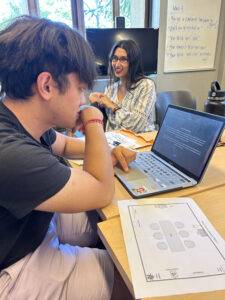P2-Team 22: Ben H, Shuvi J, Jasmine N, Jailia Y
Artist’s Statement
Our game Out of Office explores themes of corruption, secrecy, and whistleblowing within the fictional corporate giant, Globex Corporation. Designed for solo play, the game immerses players in the role of Nina’s best friend, who embarks on a quest to uncover the truth behind Nina’s mysterious disappearance. Through a series of immersive puzzles and critical decision-making, Out of Office challenges players to expose the hidden corruption within Globex.
Out of Office is deeply influenced by our surroundings and experiences as Stanford students living in Silicon Valley, an area synonymous with technological innovation and corporate culture. This backdrop has inspired a narrative that resonates with the ideas of ambition, ethics, and the pursuit of justice. Thus, a player’s journey through Out of Office is a reflection on personal integrity and the impact of individual actions on a larger scale.
Targeted at young adults and adults who enjoy escape room games, Out of Office is designed to appeal to those who relish in solving puzzles while unraveling a compelling narrative. The game offers an engaging and thought-provoking experience that encourages players to question what they would do in the face of widespread corporate wrongdoing.
By intertwining gameplay with moral dilemma, Out of Office not only seeks to entertain but also inspire players to consider the complexities of loyalty and justice. It is a game that challenges the mind and stirs the conscience, inviting players to engage with a narrative that is both compelling and critical.
Model
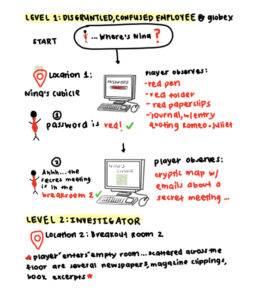
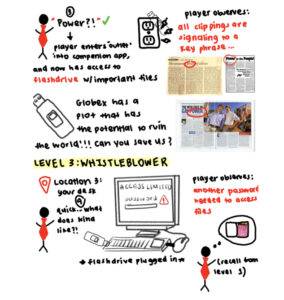
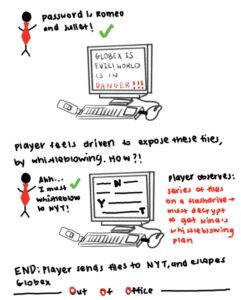
Initial Decisions
Ideation and Pivot
Our team initiated the brainstorming process with two key desires: we wanted to create a game that was primarily analog with strategic digital enhancements, and we wanted to incorporate a theme that is unique and engaging.
We began with Queen of the Court, our initial game. Queen of the Court is a narrative-driven game themed around the quintessential high school experience of running for prom queen. We drew on inspiration from books such as To All the Boys I’ve Loved, interactive fiction games like Episode, and films such as Teen Spirit and The DUFF. We sought to create a relatable yet entertaining narrative.
However, after our first playtest and subsequent discussions with members of the teaching team, we pivoted from Queen of the Court to Out of Office. During the initial playtest, it became apparent that Queen of the Court’s narrative was fundamentally reliant on extensive player choices and created a branched storyline. For example, in Queen of the Court, players could decide which side characters to interact with or which set of actions to take on the night of prom. We discussed this observation with the teaching team, who suggested adapting the game into an interactive fiction or visual novel format to better accommodate the narrative style. However, this direction sharply diverged from our initial vision of creating a game centered around analog puzzles. Moreover, we were cautious about drifting toward a dating sim or similarly themed game, which did not align with our interests or goals. Faced with these thematic and narrative mismatches, we decided to shift our focus and develop Out of Office, a game that better suited our original intentions of integrating narrative depth with tangible, puzzle-solving gameplay.
Values
In Out of Office, we carefully selected core values that resonate with both our creative goals and the game’s intended audience. These values not only appeal broadly but are deeply aligned with the strengths and passions of our team. For instance, our interest in crafting a compelling narrative integrated with engaging puzzles ensures that the game connects with players on a meaningful level. By prioritizing these core values, we aim to create an experience that embodies entertainment and enjoyment.
- Strong Narrative: We are passionate about narrative-driven games and designed Out of Office to immerse players deeply in the story. Players unravel the narrative through gameplay.
- Player Engagement: We aim for players to be actively engaged and use the puzzles not just as obstacles but as means to deepen the narrative experience.
- Relatability: We chose a theme that mirrors the corporate world through a lens of corruption and escape, ideally making the theme engaging and entertaining for players.
Formal Elements
We crafted the formal elements of Out of Office to create a coherent gameplay experience.
- Players: The game is designed for solo play, setting the player against the game itself. The primary obstacles are the puzzles they must solve.
- Procedures and Rules: Out of Office emulates an escape room in a box. Players progress through different corporate rooms, each represented by a box containing the corresponding puzzles and artifacts.
- Boundaries: The game confines players to the resources within each box. Interaction with external devices such as laptops are controlled and confined to the game’s narrative.
- Objectives: Players must uncover the reasons behind Nina’s disappearance and further her mission to whistleblow against Globex Corporation.
- Outcomes: If players successfully complete the puzzles, they whistleblow and this results in winning the game.
Use of Space
Out of Office utilizes space by dividing the game into three distinct boxes, each representing a different location in the corporate office of Globex Corporation. This structure encourages players to mentally inhabit the three spaces, in which each box contains the artifacts and puzzles necessary to advance the narrative during each section of the game. While the game design generally guides players to move forward through the boxes, one puzzle uniquely requires players to recall information from previous boxes. Although revisiting previous boxes is possible and may assist players in completing this specific puzzle, the challenge is primarily designed to rely on the player’s memory, thus enhancing engagement and deepening player interaction with the game’s narrative. This approach not only keeps the gameplay dynamic but leverages spatial memory as a key element in the puzzle-solving process.
Embedded Narrative
The narrative of Out of Office is intricately woven into the structure of the game. While much of the story is predetermined, the discovery and progression are entirely in the hands of the players, placing the fate of Globex Corporation directly under their control. As players solve puzzles, they must continuously revise and expand their mental map of the narrative. This makes each decision and discovery a vital piece of the game. For example, as players uncover clues about Nina’s disappearance, they update their understanding of her motivations and the risks she faced within the company. This may lead them to reassess which allies within Globex could be trusted and how Nina covertly communicated with them. Additionally, players refine their strategy based on the information learned from each box, deciding how to leverage this knowledge to influence the unfolding events. This approach ensures that the game remains both challenging and engaging, with the player’s actions having a significant impact on the resolution of the story and future of Globex Corporation.
Testing and Iteration History
Playtest 1
What we tested: Does the narrative [of Queen of the Court] depend on player choice too much?
Our initial playtest focused on assessing the narrative, as well as gameplay format and potential puzzle integration for Queen of the Court. Feedback from playtesters led to several critical insights:
- Narrative feedback: Playtesters expressed that the narrative heavily depended on player choices, suggesting a need for multiple paths and branching outcomes based on interactions with side characters.
- Gameplay dynamics: There was a strong suggestion to incorporate mechanics such as social deduction and sabotage, especially as a climax event. Additionally, the idea of implementing special skills or roles for players that could influence their success and interactions was discussed.
- Character interaction: Questions arose regarding how side characters would interact with the player and whether players could form alliances with multiple characters to influence different narrative outcomes.
- Game format: Feedback indicated a preference for switching from a multi-player format to a single-player format. This shift would fit the narrative-driven game where personal choice and character development were crucial.
- Puzzle integration: Suggestions for puzzle integration were tied to the narrative elements, such as building alliances or handling crisis events like sabotage on prom night.
Based on these insights, we made the decision to discontinue development of Queen of the Court. The feedback was instrumental in highlighting that the game’s narrative direction and possible puzzle mechanics were not aligning with our team’s vision and enjoyment. This realization prompted us to focus away from Queen of the Court, but we continued to apply the lessons about narrative complexity and player engagement to the development of our final game.
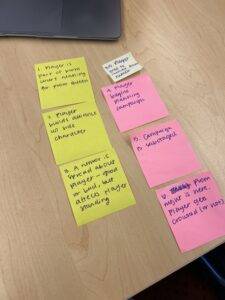
Playtest 2
What we tested: How do the puzzles flow with the narrative?
During this playtest, we focused on the new game, Out of Office. Some key findings emerged concerning the integration and flow of puzzles with the narrative:
- Puzzle-narrative integration: Feedback emphasized a need for tighter integration between the puzzles and narrative. It was noted that the timing of narrative elements needed better alignment with puzzle solving to enhance player immersion.
- Introduction of key elements: There was a suggestion to introduce significant plot elements, like a mole, earlier in the game (during Puzzle 1) instead of later. This early introduction could potentially anchor the narrative more strongly from the beginning.
- Game length: The game seemed relatively short based on the puzzles provided. This suggested the need for either additional puzzles or more complex puzzles to extend gameplay duration and depth.
- Flow and timing: The playtest raised questions about how the narrative should be delivered in conjunction with puzzle progression. We recognized the need to determine optimal moments for narrative parts to be introduced, so players maintained engagement and connected with the unfolding story.
We conducted this playtest amongst our team, so we were able to quickly iterate using our own feedback. The changes we made were:
- Puzzle integration: We revised the puzzles to better integrate into the narrative of the game by providing context clues and transitional narratives. This way, players were aware of their current position within the story when they encountered puzzles. This also ensured that the puzzles feel like a natural extension of the narrative, rather than isolated challenges.
- Later introduction of plot elements: We restructured the game to introduce the mole character in the later puzzles. This change was intended to evaluate how players react to the mole character disrupting the climax event of almost reaching the end, or whistleblowing, setting the tone for suspense and quick strategic thinking.
Playtest 3
What we tested: How natural is it to introduce the mole halfway through the narrative?
For this playtest, we directly followed up on the prior playtest and introduced the mole later in the game. This gameplay provided us critical feedback and led to significant decision-making:
-
- Relevance of the mole: This playtest revealed that the mole character was not adding as much value to the game as initially anticipated. The playtester did not find this element engaging or valuable to the gameplay experience.
- Need for clear instructions: Feedback from the playtester highlighted a need for clearer instructions for the puzzles to help guide them without giving away solutions.
- Puzzle comprehension and engagement:
-
- Puzzle 1 (Desk Items as Laptop Password): Playtester understood the premise but expressed confusion about the mechanics, indicating a need for more intuitive design or clearer instructions.
- Puzzle 2 (Email Thread and Cryptic Map): This puzzle was solved quickly but highlighted a need for better integration with subsequent puzzles to maintain a cohesive narrative flow.
- Puzzle 3 (Corporate Memos): Playtester misinterpreted the content of the memos as clues, which was not the intended design. This helped us realize that supporting information must be intentionally presented to ensure it does not confuse players.
Following this playtest, we made these changes:
- Integrating puzzle instructions within narrative: We revised the way puzzle instructions were delivered, embedding them into the game’s narrative. This approach ensures that guidance is provided contextually, so the storytelling aspect is enhanced while supporting the puzzle-solving.
- Content intentionality within puzzles: We became more deliberate in curating puzzle content, ensuring that even non-essential or misleading information is clearly marked or integrated in such a way that does not lead to player confusion. This involved reevaluating how information is presented and ensuring that each piece adds value to the gameplay and narrative understanding.
- Removal of the mole character: We made the decision to remove the mole character to streamline the game’s plot. This allowed us to introduce other narrative elements and ensure that every character and plot point contributes to the main objective of whistleblowing.
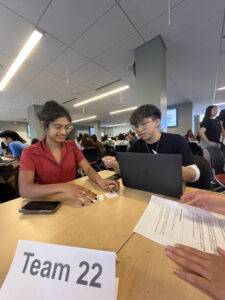

Playtest 4
What we tested: Are the puzzles and narrative fun? Enjoyable?
This playtest aimed to assess whether the integration of the puzzles and narrative were both fun and enjoyable. The major insights included:
-
- General feedback: The playtester expressed confusion about what was expected in the puzzles and noted a uniform difficulty level throughout the game. They also noted that some puzzle artifacts felt out of place and did not fit the setting of our game’s narrative.
- Puzzle comprehension and engagement:
-
- Puzzle 1 (Crossword Puzzle for Laptop Password): The playtester found it unnecessary to complete the entire crossword noting that only one answer was required for the companion app.
- Puzzle 2 (Email Thread and Cryptic Map): The playtester successfully completed this puzzle, but it indicated the need to ensure that hints are intuitive without revealing the solutions.
- Puzzle 3 and 4 (Tiled Image and Whiteboard): The playtester focused more on supporting artifacts than the main puzzle elements. They found it difficult to make connections between the provided artifacts and the whiteboard’s phrase. This suggested a misalignment of puzzle components with the game’s theme.
- Puzzle 5 (Flash Drive Password): The playtester quickly completed this puzzle.
- Puzzle 6 (Burner Cell Morse Code): The playtester did not test this puzzle.
Using this insight, we made the following changes:
- Adjusting puzzle difficulty: We implemented a varied difficulty curve throughout the game, alternating between easier and more challenging puzzles. This approach was designed to ensure player interest and provide incentive to continue playing the game.
- Removal and replacement of puzzles:
- Puzzle 1 (Crossword Puzzle for Laptop Password): Recognizing that the crossword puzzle did not significantly contribute to the narrative and the crossword artifact did not fit the context of the game, we decided to remove this puzzle. We reintroduced the previous Puzzle 1 that utilized Nina’s desk items.
- Puzzle 3 (Tiled Image): We removed this puzzle as it was deemed unnecessary and did not contribute to the gameplay. We wanted to streamline the game by not combining multiple puzzles, like we combined Puzzles 3 and 4.
- Puzzle 6 (Burner Cell Morse Code): Although the playtester did not test this puzzle, we decided to remove it and introduce a new decoding puzzle that plays into the major plot point of whistleblowing.

Playtest 5
What we tested: How do players approach the contents on the flash drive? Is Puzzle 5 correctly discovered and played at the very end?
In this playtest, we aimed to assess the revamped puzzles, focusing on their clarity and solvability. At this point in the process, we had restructured the game to be organized into three distinct boxes. Here are the key findings:
- Box 1: Nina’s Cubicle:
-
-
- Puzzle 1 (Desk Items as Laptop Password): The playtester was initially unsure when to start interacting with the game items, indicating a need for better narrative cues to guide player actions from the beginning.
-
- Box 2: Breakout Room 2:
-
-
- Puzzle 3 (Email Thread and Cryptic Map): This was the playtester’s favorite puzzle.
- Puzzle 3 (Whiteboard): The playtester quickly completed this puzzle without utilizing the supporting artifacts. This indicated a need for better contextual relevance of these artifacts within the puzzle.
-
- Box 3: Your Cubicle:
-
- Puzzle 4 (Flash Drive Password): The playtester was unclear about the significance of items used in previous puzzles and found the hint unclear. This signaled the need for more specific and detailed narrative hints.
- Puzzle 5 (Whistleblowing Riddles): The playtester found some riddles too open-ended and suggested enhancing the puzzle with a word bank or allowing multiple input forms to confirm correct answers.
We iterated on these key findings in the following ways:
- Improved narrative clues: For Puzzle 1, we refined the wording and incorporated more explicit cues into the narrative to ensure players understand when and how to interact with the game elements. This adjustment was made to reduce initial confusion and provide a smoother start to the game.
- Enhanced puzzle complexity and content: For Puzzle 3, we selected more challenging artifacts that require deeper analysis and clearer connections to the puzzle’s theme. We wanted to encourage more thoughtful engagement and use of the supporting artifacts to enhance the overall puzzle-solving experience.
- Scaffolded hints and information: For Puzzle 4, we worked on integrating more detailed and scaffolded hints throughout the game’s narrative. This approach ensures that by the time players reach Puzzle 4, they have been gradually provided with all the necessary information to solve the puzzle without ambiguity or having to revisit prior puzzles.
- Introduction of a word bank: For Puzzle 5, we introduced a word bank to aid in solving the riddles. This addition allows players to focus more on solving the puzzle based on their understanding of the narrative, rather than struggling with the format of their responses.
Playtest 6
What we tested: Does the word bank make Puzzle 5 too easy? Does the modified narrative (hint) help in Puzzle 1?
This playtest aimed to assess the effectiveness of a word bank for Puzzle 5 and the impact of modified narrative hints for Puzzle 1. This is what we found:
- Box 1: Nina’s Cubicle:
-
-
- Puzzle 1 (Desk Items as Laptop Password) : The playtester was immediately confused about relevance and connection of the clues. They also felt overwhelmed by the quantity of artifacts, since there were many memos to read through.
- Puzzle 2 (Email Thread and Cryptic map): This puzzle was the playtester’s favorite.
-
- Box 2: Breakout Room 2:
-
-
- Puzzle 3 (Whiteboard): The playtester found it challenging to understand how the artifacts were interrelated and relevant to the narrative.
-
- Box 3: Your Cubicle:
-
- Puzzle 4 (Flash Drive Password): The playtester felt like the hint was too direct, making the puzzle less challenging than intended.
- Puzzle 5 (Whistleblowing Riddles): The playtester managed to solve only two out of three riddles, pointing to potential issues in riddle clarity and construction.
We implemented these changes:
- Improved narrative clues: For Puzzle 1, we refined the content of the memo pad to subtly hint at the laptop password without being overly explicit. This was done to reduce player confusion and ensure smoother engagement with puzzle elements.
- Adjusted hint directness: We revised the hint to be less obvious for Puzzle 4. This change was made to enhance the challenge of this puzzle, encouraging players to engage more deeply with the puzzle content and rely less on direct clues.
- Enhanced riddle clarity: For Puzzle 5, we adjusted one of the riddles to make its solution more apparent without simplifying the challenge. We wanted all puzzles to be solvable with a reasonable level of deductive reasoning, supported by the newly introduced word bank.
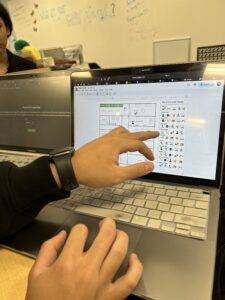

Playtest 7
What we tested: Does the scaffolded narrative about Shakespeare help Puzzle 4 feel more integrated and natural?
This playtested assessed the difficulty of new narrative hints in Puzzle 4. Here are the key findings:
- Box 1: Nina’s Cubicle:
-
-
- Puzzle 1 (Desk Items as Laptop Password): The playtester suggested reducing the number of memos, decreasing the reading load and encouraging players to focus more on relevant details.
- Puzzle 2 (Email Threads and Cryptic Map): Artifacts, such as the room descriptions, were found unclear. The playtester suggested using formatting like bolding to highlight important words.
-
- Box 2: Breakout Room 2:
-
-
- Puzzle 3 (Whiteboard): The playtester suggested improving the hint by directly describing the answer rather than providing additional clues on how to find the answer.
-
- Box 3: Your Cubicle:
-
- Puzzle 4 (Flash drive Password): Feedback indicated reluctance to use the hint immediately, but the playtester eventually needed to use the hint to complete the puzzle. This suggested a need for more intuitive puzzle integration.
- Puzzle 5 (Whistleblowing Riddles): The playtester enjoyed the concept of whistleblowing but found the word bank too extensive. They suggested reducing the size of the word bank and adding clearer narrative hints about the mechanics of the puzzle. Additionally, the playtester desired more engaging riddles.
This playtest led us to make the following changes:
- Enhanced narrative detailing: We continued to flesh out the narrative to reduce reliance on direct hints. We hoped to create a more immersive storytelling approach that naturally leads players through the puzzles.
- Streamlined reading experience: We minimized the amount of text displayed on the screen of the companion app, so digital interactions feel less burdensome and more engaging.
- Reformatting of puzzle content: For Puzzles 2 and 5, we bolded important phrases to help players quickly identify crucial information.
- Refined riddles: For Puzzle 5, we revised the riddles to be longer and more challenging. We wanted players to have more interest in the content of the riddles, while still being able to identify key phrases using the introduced reformatting.



Playtest 8
What we tested: Are the new riddles in Puzzle 5 too difficult? Does putting them in order make it easier to decipher?
This playtest session focused on evaluating the riddles across Puzzle 5, as well as all of the puzzles across the three boxes. Here are the major insights:
- Box 1: Nina’s Cubicle:
-
-
- Puzzle 1 (Desk Items as Laptop Password): The playtester suggested enhancing the interactive discovery of puzzle components by hiding items inside the folder, which could be found by the players themselves.
- Puzzle 2 (Email Thread and Cryptic Map): This was the player’s favorite puzzle.
-
- Box 2: Breakout Room 2:
-
-
- Puzzle 3 (Whiteboard): The playtester was confused about the relevance of the whiteboard.
-
- Box 3: Your Cubicle:
-
- Puzzle 4 (Flash Drive Password): The playtester highlighted the need to balance textual information with visual cues to maintain player engagement without overwhelming them.
- Puzzle 5 (Whistleblowing Riddles): Feedback indicated that the new riddles were too difficult and overly open-ended.
With this feedback, we iterated in the following ways:
- Enhanced puzzle integration and immersion:
-
-
- Puzzle 4 (Flash Drive Password) and Puzzle 5 (Whistleblowing Riddles): We made the file names on the flash drive more cryptic, increasing the intrigue involved in exploring the flash drive.
- Puzzle 1 (Desk Items as Laptop Password): Memos were handwritten and placed inside the folder to enhance the tactile and discovery elements of the puzzle, offering a more engaging and immersive experience.
-
- Removal of puzzle components:
-
-
- Puzzle 3 (Whiteboard): We removed the whiteboard component and retained only the article artifacts that directly contribute to the narrative and puzzle clarity. This change simplified the puzzle and enhanced focus on relevant elements only.
-
- Reverting puzzle difficulty:
-
- Puzzle 5 (Whistleblowing Riddles): In response to feedback about the difficulty of the new riddles, we reverted to the original riddles while maintaining emphasis on key phrases by bolding them. We aimed to preserve the challenge while ensuring clarity and solvability of the puzzle.


Playtest 9
What we tested: Are the puzzles and hints intuitive?
This session focused on evaluating the intuitiveness of the puzzles and their supporting hints across the three boxes. The key findings include:
- Box 1: Nina’s Cubicle:
-
-
- Puzzle 1 (Desk Items as Laptop Password): The playtester appreciated the hint system but felt that the hint for this puzzle was not sufficiently helpful.
-
- Box 2: Breakout Room 2:
-
-
- Puzzle 2 (Email Thread and Cryptic Map): The playtester overlooked using the room descriptions, indicating they were not effectively highlighted within the game.
- Puzzle 3 (Article Headlines): This simpler, image-based puzzle was well-received for its straightforwardness.
-
- Box 3: Your Cubicle:
-
- Puzzle 4 (Flash Drive Password): The playtester relied on memory to solve this puzzle and suggested incorporating more subtle memory cues that do not simplify the challenge too much.
- Puzzle 5 (Whistleblowing Riddles): The depth of immersion in solving the riddles led the playtester to overlook the input field on the companion app for submitting answers. They suggested clearer in-puzzle reminders to interact with the companion app.
Using these insights, we made the following changes for our final playtest:
- Refined hint system: We refined the hint system across all puzzles to ensure that hints are both useful and adequately directive. We aimed to avoid redundancy and ensure that hints progressively guide players without reiterating steps they may have already taken.
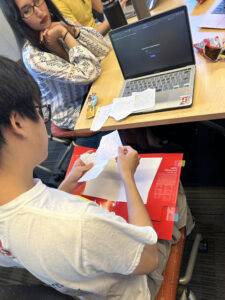
Playtest 10
What we tested: How do the modified hints affect gameplay? Are they too helpful?
This final playtest specifically evaluated the revised hint system. The key findings are:
- Hint usage: The playtester managed to complete all puzzles independently but relied on all provided hints, indicating that while the hints are useful, there might be an over-reliance on them. This is especially challenging since there is no punishment for incorrectly submitting an answer on the companion app, and the hints appear after three wrong attempts, regardless of how close the answers were.
- Narrative impact: Despite minimal interactive elements in the game, the playtester found that the well-crafted narrative effectively compensated, making the game enjoyable.
